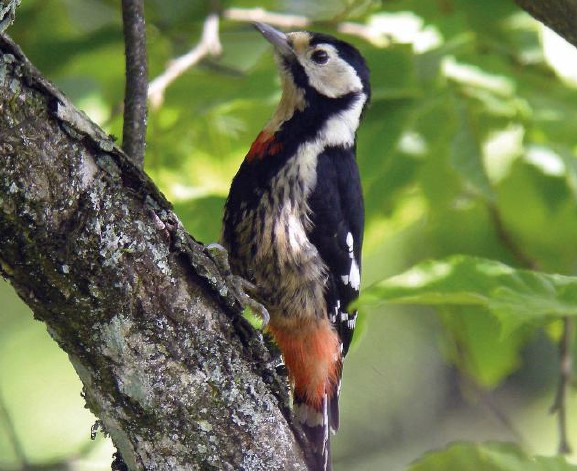Size: The crimson-breasted woodpecker or scarlet-breasted woodpecker (Dendrocopos cathpharius) is about 17–18 cm in length.
Identification: The woodpecker has a variable crimson band across the chest, not always obvious; some also have a black band. The chin and throat are white, while the buff or white underparts are streaked black. The vent is often red or pink faint, along with a plain black mantle, back, and scapulars.
Black wings with white patches on coverts; primaries with white spots or bars. The upper tail is black, the outer feathers are white, and the undertail is barred black and white. The forehead is white, while the crown is black; ear-coverts are buff or white. The black malar extends to the rear neck and meets the black line from the chest. Iris chestnut and the orbital ring are gray. The upper mandible is mid-grey, the lower paler, and the legs are grayish.
The sexes differ, as the male woodpecker has a variably-sized red patch on the nape, which the female lacks (though some are golden or orange), and the female is also less red on the chest. Juvenile usually lacks red on the chest, is less streaked below, has paler, reduced pink on the vent, and has larger white primary tips; both sexes have orange or red on the nape, more extensive in males.
Vocalizations: The call of Crimson-Breasted Woodpecker is quite loud, high-pitched, repeated chip, tchik or skik notes, sometimes linked in an intense, rapid, rattling, falling series, and also a shrill kee-kee-kee. Whereas the drumming is a slight, short, but fast roll of even tempo that begins gently before increasing strongly.
Habitats: The crimson-breasted woodpecker is found in various upland tropical broad-leaved forests, especially with rhododendron, chestnut, and some dead wood. The range is Southeast Asia. From north-east India to China, Indochina, and Thailand. It is found about 800–3900 meters, but more often than not between 1300–3000 meters. It is Resident and most likely sedentary. Normally, this species lives in subtropical or tropically moist lowland forests as well as subtropical or tropically moist montane forests.
Taxonomy and variations: There are six races with varying extents of red areas, underpart color, and markings. Nominate cathpharius (Eastern Himalayas: Nepal and North Assam) often buffs below the chest with minimal red and no black; ludlowi (South East Tibet) is larger than nominate with more red on chest; pyrrhothorax (North East India, North West Burma (Myanmar), Bangladesh) is much more red and black on chest, nape, and under-tail-coverts. But pale on underparts and face; pernyii (Central and Western China: Northern Western Yunnan, Sichuan, Xinjiang N to Gansu) has red on head restricted to nape, red chest bordered by bold black below; innixus (North Central and East Central China) underparts less streaked, red chest bordered by black below previous race; tenebrosus (N Burma (Myanmar) to Thailand, Laos, N Vietnam and Yunnan, China) is relatively small, heavily streaked with much black on the chest.
Similar species: The sympatric Darjeeling Woodpecker is a bit bigger, has a larger bill, but lacks red on the chest and yellow on the neck.
Food: The crimson-breasted woodpecker mainly depends on insects, particularly larvae, supplemented with nectar and probably other plant matter. Forages alone or in pairs, rarely seen in mixed flocks, are low down on live and dead trees and in bushes. Frequently works outer twigs that larger relatives ignore.
Status: The woodpecker is fairly common to rare. Thus, the overall population considered stable, but data lacking.
Read More: The South American Little Woodpecker

